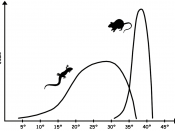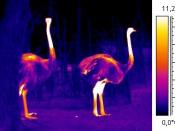- ECTOTHERMS are organisms that have a limited ability to control their body temperature. Their cellular activities generate little heat. Their body temperatures rise and fall with ambient temperature changes. Most organisms are ectotherms. Examples are plants, all invertebrates, fish, amphibians and reptiles
- ENDOTHERMS are organisms whose metabolism generates enough heat to maintain an internal temperature independent of the ambient temperature. Examples are birds and mammals
- EXTENSION (Not really needed but anyway...)
Poikilotherms are animals whose body temperatures are always changing. True poikilotherms have temperatures that are the same as the environment. An example is jellyfish. Poikilothermy is often assumed to be the same as ectothermy; however, this is incorrect. Some ectotherms, like snakes, can regulate their temperatures using behaviour to maintain a stable temperature.
Homeotherms are animals with stable body temperatures. Most endotherms are also homeotherms.
The poikilotherm/homeotherm classification system was based on the stability of the body temperature of the organism.
This system is now redundant.
The ectotherm/endotherm system uses the organism's source of body heat as a way of classification. This system is accepted today.
- BEHAVIOURAL ADAPTATIONS:
Migration: Animals can move to avoid temperature changes. Many birds that spend spring and summer in Australia migrate before the temperature becomes cold.
Hibernation: To survive cold conditions, many animals hibernate; that is they remain in a sheltered spot, their metabolism slows and the body temperature drops. Aestivation is the 'hibernation' of organisms in heat conditions. Bogong moths migrate to spend the summer months in caves in the Australian Alps
Shelter: Animals seek shelter to avoid extreme conditions. They can dig burrows or seek shelter in caves or crevices. They can shelter to avoid high temperatures or avoid low temperatures. An example is the central netted dragon
Nocturnal Activity: Brown snakes can change into nocturnal animals when...


